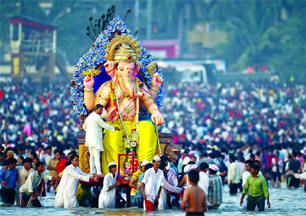
The festival of Ganesh Chaturthi is celebrated to honor the Hindu god Ganesh. The festival, also known as Vinayaka Chaturthi is observed in the Hindu calendar month of Bhaadrapada, starting on the shukla chaturthi (fourth day of the waxing moon period) and lasts for 10 days, ending on Anant Chaturdashi (fourteenth day of the waxing moon period). People start celebrations by preparing months in advance by making eco-friendly idols, artistic clay models of Lord Ganesha and decorating the idols.
The size of these idols vary from inches to feet. Ganesh Chaturthi starts with the installation of these Ganesh statues in colorfully decorated homes and specially erected temporary structures mandapas (pandals) in many localites. The pandals are decorated using decorative items like flower garlands, lights, etc.. Some pandals are made theme based which depict religious themes, events related to Lord Ganesha or sometimes current events.
There are many legends surrounding the celebration of Ganesha Chaturthi. The most well-known of these are related to Lord Shiva and Parvati. According to legend, Parvati used sandalwood to create Ganesha while her husband, Shiva was away. She designated Ganesha to watch over her house’s entrance while taking a bath. When he returned, Ganesha blocked Shiva from entering the building, eager to meet Parvati. This caused the two of them to fight. He initially makes vain attempts to persuade the boy. Shiva, the god of destruction, finally cuts off Ganesha’s head.
When Parvati caught sight of this scene, she transformed into the goddess Kali and declared that she would end the world. Everyone was concerned about this and prayed to Lord Shiva to find a solution and subdue Goddess Kali’s rage. Shiva then commanded all his followers to run off and find a child whose mother was neglectful, turning her back on her child and bringing his head. The followers saw the first child as an elephant, so they cut off his head and brought it to Lord Shiva as instructed.
The head was immediately placed on Ganesha’s body by Lord Shiva, who then revived it. Goddess Parvati was once more overpowered as Maa Kali’s rage subsided. Ganesha or Ganapati, the chief of the ganas or the attendants of Shiva, was given a warm welcome into the first family of the Hindu heavens and given the elephant-headed god’s name. The most important god in the Hindu pantheon is Ganesha. This valiant doorkeeper for Parvati’s bath is revered as the most auspicious deity of fresh starts. He is worshiped before people travel or start a new project and during all festivals. You will also see him carefully guarding entrances to temples and homes, peeping out of calendars and happily gracing marriages and other such occasions.
Puranas say that on the fourth day of the month in the Hindu calendar, Saka Samwat, devotees observe a fast and worship Lord Ganesha on Chaturthi. Ganesha is said to have been born on Bhadra Chaturthi, which falls between August and September.
Even though Ganesh Chaturthi is celebrated as Lord Ganesha’s birthday, freedom fighter Lokmanya Tilak revived the celebration of Ganesh Utsav in Maharashtra, making it more popular among the general public.
Through his efforts, the festival became a ten-day celebration. On the tenth day of the celebration, devotees carry Ganesha idols alongside singing and moving to drench it in water. The name of the procession is Visarjana.
Rituals of Ganesh Chaturthi
Selecting a Ganesha Idol
It is considered very lucky to choose an idol of Lord Ganesha. Because it is a representation of happiness and prosperity, a sitting Ganesha idol is suggested. In addition, it would be ideal for the idol to depict one of Ganesha’s hands in a blessing position and the other holding a modak, a deity-favored sweet.
Installation Direction
It is essential to position the Ganesha idol so that it faces the north side and is erected in the northeast direction of your home. First, pick a clean platform, cover it with a cloth, and set the idol on it. It is believed that this position brings blessings and positive energy into the home.
Worship Rituals
As part of the purification ceremony, rice and pure Gangajal (holy water) should be sprinkled on the deity after it has been installed. Along with the idol, you must also place Riddhi and Siddhi, which are representations of spiritual power and prosperity.
On the idol’s right side, a water container should be placed. Make an offering of flowers, fruits, and sweets, particularly modaks, to Lord Ganesha following these preparations. Finish the ritual of worship by reciting mantras and waving lighted lamps in front of the deity in the form of an aarti.
Significance of the Ganesh Chaturthi
The celebration is also known as Ganesh Utsav or Vinayaka Chaturthi. Lord Ganesha is also known as ‘Vignaharta’, and that implies the one who removes hurdles. The celebration is an ideal chance for devotees to look for help from above for life’s regular difficulties.




Be the first to comment